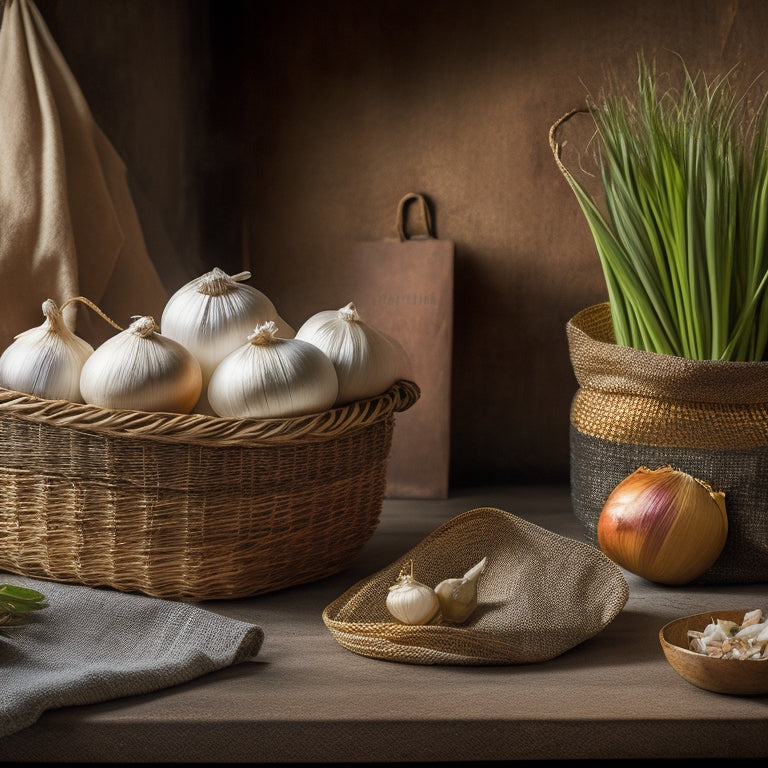
Preserve Onions, Garlic, and Shallots Like Pro
Share
To preserve onions, garlic, and shallots like a pro, it's important to provide ideal storage conditions that promote air circulation and organization. Brown paper bags with holes, markers, and paper clips are necessary supplies for this task. By storing them in a cool, dark, and dry environment, you can extend their shelf life up to three months. Proper air circulation is crucial, and maintaining a consistent temperature and humidity level is necessary. Mastering the storage technique and following best practices can greatly impact the freshness and quality of these kitchen staples. By understanding the intricacies of storage, you can maximize the full potential of your onions, garlic, and shallots.
Key Takeaways
• Use brown paper bags with holes for air circulation to store onions, garlic, and shallots for up to three months.
• Store them in a cool, dark, and dry environment to slow down ripening and prevent spoilage.
• Avoid storing onions, garlic, and shallots near potatoes to prevent cross-contamination of flavors and moisture.
• Organize them effectively using paper clips and cardboard boxes or baskets to maintain air circulation and prevent moisture buildup.
• Keep them away from strong-smelling foods and refrigeration to preserve their texture and flavor.
Storage Essentials and Benefits
Proper storage of onions, garlic, and shallots is dependent on using the right supplies and techniques, which not only prolongs their shelf life but also maintains their quality and freshness. Necessary storage supplies include brown paper bags, hole punches, markers, and paper clips, which facilitate ideal air circulation and organization.
By using these supplies correctly, onions, garlic, and shallots can be stored for up to three months, preventing waste and spoilage. Proper air circulation is vital, and paper bags are perfect for this purpose. Effective storage also involves maintaining a cool, dark, and dry environment, which slows down the degradation process.
Mastering the Storage Technique
To master the storage technique, it is crucial to understand the importance of maintaining ideal air circulation around the onions, garlic, and shallots, which can be achieved by using brown paper bags with strategically placed holes. This expert advice ensures that your stored onions, garlic, and shallots remain fresh and flavorful for a longer period.
Here are some storage hacks to elevate your storage game:
- Use brown paper bags with holes to sustain air circulation and prevent moisture buildup
- Place bags in a cool, dark area to decelerate the ripening process
- Avoid storing onions, garlic, and shallots near potatoes to preclude cross-contamination of moisture and flavors
- Implement DIY storage solutions, such as using paper clips to seal bags and keep them organized
- Get inventive with your storage by using cardboard boxes or baskets to keep bags separated and ventilated
Storage Tips and Best Practices
In addition to mastering the storage technique, observing specific guidelines and best practices is crucial to safeguard the longevity and quality of stored onions, garlic, and shallots. Proper organization is key to effective preservation.
Store onions, garlic, and shallots in cool, dark, dry areas, away from potatoes and strong-smelling foods. Use plastic bins to uphold air circulation between bags and prevent moisture buildup. Avoid refrigerating onions to maintain texture and flavor.
Implementing these best practices guarantees that your stored onions, garlic, and shallots remain fresh and flavorful for an extended period. By following these guidelines, you can enjoy your stored alliums for months to come, while minimizing waste and maximizing convenience in the kitchen.
Maintaining Freshness and Convenience
By implementing the most effective practices outlined above, home cooks and chefs can now focus on maintaining the freshness and convenience of their stored onions, garlic, and shallots, ensuring ideal flavor and texture in their culinary creations. To achieve this, it is essential to adopt certain habits and techniques that promote freshness maintenance and time-saving convenience.
-
Keep extra punched bags for easy refilling and storing new batches.
-
Store garlic press and peeler with garlic for convenient access.
-
Consider using an easy garlic peeler for quick preparation.
-
Embrace the technique to reduce waste and enhance freshness.
-
Stay organized for efficient cooking and meal preparation, ensuring that your stored onions, garlic, and shallots remain fresh and ready to use.
Understanding Storage Longevity Factors
An essential aspect of preserving onions, garlic, and shallots is understanding the factors that influence their storage longevity. These factors include temperature, humidity, and storage methods, which can greatly impact the duration of freshness.
Temperature impact is significant, as onions, garlic, and shallots require cool, dark storage to maintain freshness. Humidity levels also play an ideal role, with best storage occurring at relative humidity between 60-70%. Proper storage methods, such as using paper bags with air circulation, can also extend storage longevity.
Conversely, incorrect storage conditions can lead to spoilage and reduced shelf life. By grasping these factors, individuals can optimize storage conditions to preserve onions, garlic, and shallots for an extended period, ensuring maximum freshness and flavor.
Frequently Asked Questions
Can Onions, Garlic, and Shallots Be Stored Together in the Same Bag?
While it may seem convenient, storing onions, garlic, and shallots together in the same bag is not recommended, as it can lead to cross-contamination and moisture buildup, compromising proper storage techniques and ideal storage conditions.
Do Onions, Garlic, and Shallots Need to Be Washed Before Storage?
Imagine a crisp, dry storage space, where onions, garlic, and shallots thrive. Before storage, gently brush off dirt, avoiding excessive moisture. Proper cleaning and ideal storage conditions are essential, ensuring freshness and longevity, while preventing spoilage and decay.
Can Stored Onions, Garlic, and Shallots Be Used for Planting?
Stored onions, garlic, and shallots can be used for planting, but their planting viability depends on storage longevity and seasonal planting considerations, emphasizing proper storage techniques to maintain ideal conditions for successful propagation.
How Often Should Stored Onions, Garlic, and Shallots Be Checked for Spoilage?
Regularly check stored onions, garlic, and shallots every 2-3 weeks for signs of spoilage, such as soft spots, mold, or sprouting, to guarantee freshness and best storage methods, thereby maintaining quality and preventing waste.
Are There Any Specific Onion, Garlic, and Shallot Varieties Better Suited for Storage?
When selecting onion, garlic, and shallot varieties for best storage, choose those bred for longer shelf life, such as 'Stuttgarter' onions and 'Elephant' garlic, which thrive under ideal storage conditions and best storage methods.
Related Posts
-

Why Kitchen Renovation Demands a Meal Planning Strategy
As you prep for your kitchen renovation, you'll quickly realize that the absence of a meal planning strategy is a rec...
